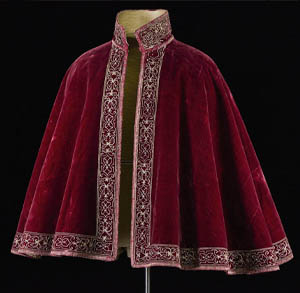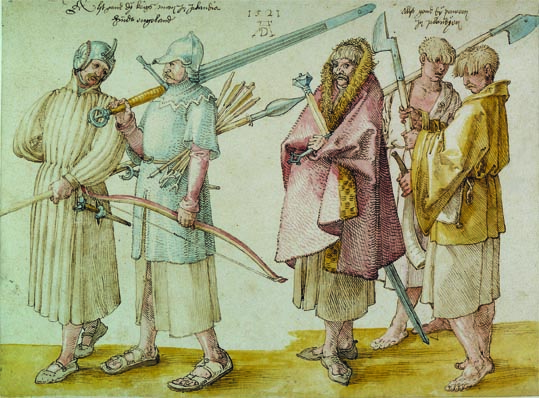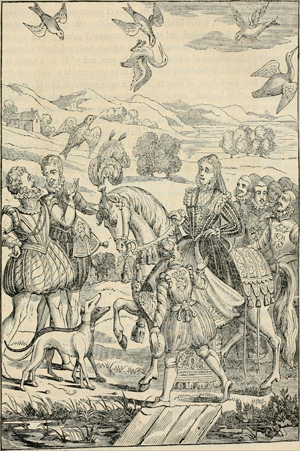‘NO MEAN DIPLOMAT’: THE GIFT EXCHANGE PRACTICES OF SHANE O’NEILL, A RENAISSANCE GAELIC LORD
Published in Features, Issue 6 (November/December 2022), Volume 30By Melissa Sheils

Above: A Spanish cape similar to the one that Queen Elizabeth I had cut down from her own wardrobe and made into a suit of apparel for Shane O’Neill. The inventory of his wardrobe taken after his assassination reveals that he had many items of international fashion, including a Spanish cape and a Dutch cloak.
‘Although he is savage in his hair, … [Shane] does not seem to me that he is savage in his brain.’ These words, written by Álvaro de Quadra, the Spanish ambassador at the English court, provide a contemporary account of Shane O’Neill as a political actor who was less barbaric and more politically agile than his detractors and enemies have hitherto allowed. Historians have studied Shane O’Neill’s political career through sympathetic and antagonistic lenses and his later representation in literature, and have even portrayed him as a ‘champio[n] of Irish nationality’. One aspect of this Gaelic lord that has not been examined to date are Shane’s extensively documented diplomatic overtures, i.e. his attempts at realising his political goals through gift exchange.
In the Renaissance era gift exchange was an essential part of diplomacy. In political spheres, gifts recognised and legitimised the honour of the participants, and were laden with semiotic messages. Cross-cultural gift-giving was often prescriptive—particular items were given to convey a subliminal message of the cultural superiority of the donor with a directive to the recipient to conform to the donor’s status quo; prescriptive gift-giving often denoted an imbalance in parity of esteem. The other type of gift-giving will hereafter be called exemplary—communicating solidarity between the participants which upheld the status quo. An examination of Shane O’Neill’s political gift exchange practices might reveal the intra- and cross-cultural fluency not only of O’Neill but also of wider Gaelic lordship.
‘NOTHING TO WEAR’
The first records of O’Neill’s participation in political gift-giving concern prescriptive exchanges, where O’Neill received overtures from the Crown. After years of hostility, Lord Deputy Sussex negotiated with Shane throughout 1561 for O’Neill to visit the court. To secure his own safety and that of his lordship while pursuing his claims in England, Shane repeatedly postponed the departure date by using a vestimentary tactic—claiming that he had no suitable clothing in which to appear before the queen; this excuse not only bought O’Neill time but also incidentally showcased his awareness of wider contemporary fashions and the sartorial protocol required when meeting a head of state. Sussex responded by offering him ‘a free gift of … a suit of apparel’ appropriate to the status of earl. It is unknown whether Sussex made good on the offer, but the fact that such a gift was on the table shows that Shane was considered a worthy candidate for the earldom.
Like any courtier or diplomat, O’Neill recognised the importance of forging relationships with many prominent members of society and not just the monarch. To this end, while on his state visit in 1562 to negotiate for his earldom, Shane told Cecil that he had come to the court with the purpose of learning civility through exposure to the magnificence of the queen and her courtiers. He thus enacted a gradual performance of conforming to English cultural standards by sartorially transforming from a savagely attired, ‘uncivilised’ chieftain to sporting the apparel of an English nobleman; he further strengthened those political and social connections by attending and hosting feasts and tilting at the ring. His active engagement with high English society drew notice and was reported by the Spanish ambassador in his correspondence: ‘You should be aware that the Queen did him a favour, being here, with some old brocade clothes of King Enrico, and that they were here mocking him’. The queen’s gift warded off the danger of Shane’s taking offence at the insults thrown at him, and thus the breakdown of negotiations. This gift further suggests that Elizabeth may initially have had some faith in O’Neill’s legal case and/or his adherence to English cultural norms and was willing to validate his inclusion in the shared community of honour through a gift of kingly apparel.

Above: ‘Thus go the soldiers of Ireland beyond England’—Albrecht Dürer’s 1521 watercolour. When Shane O’Neill submitted before Queen Elizabeth I and the court on 6 January 1562, he would have been similarly attired. (Kuperferstichkabinett Staatliche Museen, zu Berlin)
Shane, however, did not just use his time in London to make connections with the English members of the court. He also discussed his situation with the Spanish ambassador, Álvaro de Quadra, and attended Mass in his house. The ambassador was interrogated at length about their meetings after Shane’s departure, but the gift that Elizabeth commissioned for O’Neill suggests that she knew of his political intrigues with Spain while at court. A month before his departure, she ordered a suit of apparel to be made for Shane, repurposed from ‘one Spanishe cape of carnacion cloth of golde’ in her own wardrobe. Elizabeth could just as easily have ordered new garments made for Shane from the vast quantities of fabric stored in the Great Wardrobe, but transforming a cape to a garment played on the metonymic associations of the Irish mantle representing the Irish body, symbolically suggesting that Irish loyalty was as mutable to either the Spanish or the English Crown as the remaking of a garment.
Though neither Shane nor the Crown achieved their objectives with his visit, O’Neill ‘play[ed] the honest subject’ upon his return to Ulster; he also set about making alliances with former enemies, including Sorley Boy MacDonnell. To cement their fosterage agreement, Sorley Boy gifted Shane the commodities that were most valued in Gaelic society, namely cattle and horse equipment. This exchange typifies the clear delineation between what was most prized in Gaelic culture and the gifts that were most sought after between English political actors: the wider Gaelic world reckoned wealth and status in portable cattle, and one mark of true lordship was the ability to equip men as soldiers. These gifts were their own culturally specific status markers, highlighting the practical and militaristic bent of Gaelic lordship. When, however, Shane and other Gaelic Irish lords, for instance Maguire of Fermanagh, negotiated with the Crown or its agents, they displayed the cultural sensitivity required to code-switch—shifting between languages to suit a particular situation—and instead gifted English political actors with the commodities most sought after in English high society: hunting animals.
HORSES AND HAWKS
Shane O’Neill demonstrated his code-switching fluency through exemplary gift exchange. Upon his return to Ireland, he set about petitioning Sussex for a licence to send gifts of ‘horses and hawks’ to the political actors most likely to further his suits with the queen—William Cecil and Robert Dudley. O’Neill sent Dudley ‘two horsse [sic] … two hawks … & two grehounds [sic]’; to Cecil he sent ‘a horse’. To both men he promised ‘a better token & any thinge that is wthin my contry yow may comand as yor own’ if they would ‘be bold’ in pressing his suit before the queen, i.e. the restitution of his property that he had been assured would be unharmed—thousands of kine and other goods taken from his people—while he was on his state visit. By correctly identifying and sending gifts to the heads of two competing factions, Shane was not dissimilar to Cecil in playing both sides to achieve political objectives.
O’Neill sent the commodities—hawks and horses—most imbued with noble symbolism. Derived from the wildness of the Irish landscape, Irish birds of prey were famed for their particular ferocity, while Irish horses or ‘hobbies’ were desired for their surefootedness and speed. Crown agents, Anglo-Irish merchants and magnates, and Gaelic lords gifted Irish birds, hobbies and dogs in great quantity every year to the English Crown and other European monarchs, leveraging the symbolic associations attached to Irish hunting animals to communicate their cultural sophistication while advancing international negotiations. O’Neill’s giving of these particular gifts underscores his understanding of the cross-cultural significance attached to exotic goods in the wider Renaissance community of honour, besides their being the items most valued by Crown agents as emblems of their colonial mastery over Ireland and its resources. The prestations were part of an ongoing dialogue, Shane’s intention being to advance the political relationships that were central to procuring favour under the patronage system. These gifts might have inclined either recipient to move the queen in O’Neill’s favour had not Sussex interrupted the conversation and prevented the gifts from reaching their targets.
Shane’s reassertion of control over smaller Ulster lords after his return from court led the government to believe that he had no intention of holding up his end of the bargain, but his military successes at Drumcree wrung a treaty from the Crown that was much more favourable to O’Neill’s interests. Under these terms Shane had cause to hope that he would receive the validation and recognition of his claim to the earldom, as the political actor of most esteem in the province. With the mediation of members of the ascendant Dudley faction, Shane waited for the finalisation of the agreement struck with the Crown. A year of waiting for a parliament to be called, or for his would-be assassin to be punished, prompted Shane to action, but that action was not the expected fire-and-sword scourging of the weaker Ulster lords nor an attack on the garrison at Armagh. Instead, O’Neill continued to utilise his factional connections at court and sought advice from Dudley as to what action he could perform that would lead to the ratification of the treaty.
When even his compliance and military prowess over a mutual enemy—the Scottish MacDonnells in Ulster—did not yield the desired results, Shane still did not abandon the terms of the treaty but strategically attempted to leverage honour politics against Elizabeth to reach a resolution. Writing through his foster-brother, Terence Danyell, Shane skilfully tugged at the queen’s sense of proprietary honour by apologising for not sending her a gift of hawks, instead deftly blaming their mutual enemy for defrauding the English queen of her due: ‘He wylled me to wrte to you that he is veray sorrye that he can not send the hawks of the northe to the queens ma[jes]tie nor to his friends of her counsell, for that Sahirly boye do send them to the queen of Skoteland every season: as the last year he hath don sending her vii’. Despite his military success and adroit handling of the intricacies of honour politics, Shane’s matter was still not resolved; and yet he continued to uphold his part of the treaty. He kept up the discourse with diplomatic overtures of gifts, arranging to send Dudley a horse and sending unspecified ‘presents’ to Elizabeth. Yet for all his long adherence to the treaty, and his repeated diplomatic gestures, the Crown continued to string O’Neill along, leaving his liminal status as earl of Tyrone unresolved.
Finally abandoning his compliant stance after two years of unfulfilled promises, O’Neill sought to realise his objectives through entering protracted negotiations with the Earl of Argyll and the Scottish queen. All throughout 1566 O’Neill sent messengers to Argyll and the court in Edinburgh, and offered Argyll ‘great … commodit[ies] of cattle’ and land in Ulster for his tenants to settle on. These offers were coherent with Gaelic gifting strategies. Then comes the most puzzling gift of his diplomatic career: in March 1567, devoid of his usual allies and supporters, Shane sent Argyll ‘certiene garments w[hi]ch King Henry gave his father’. Here is where Shane apparently breaks protocol. Clothing, when gifted, had strong familial associations; while women gifted apparel up and down the social ladder, gifts of apparel between men appear to have entirely passed from higher to lower political actors. The many gifts of apparel given by Henry VIII to Shane’s father, Con Bacach O’Neill, embodied the paternalistic nature of Renaissance kingship in general, and their imbalanced power dynamic in particular.
‘BETTER & HYGHER THAN AN EARLE’

Above: Contemporary woodcut of Queen Elizabeth on horseback, engaging in the sport of hawking or falconry. Upon his return to Ireland, Shane O’Neill set about petitioning Sussex for a licence to send gifts of ‘horses and hawks’.
Shane had a history of adhering to exemplary gift exchange protocol, so what was he saying with these gifts? It is very likely that he did not have the more typical and appropriate birds of prey to send, since March was not the time of year to safely send them. In addition to lack of access, there is O’Neill’s own statement to consider—that he was ‘better & hygher than an earle’. These gifts, then, may be read as Shane’s attempt to translate the associated biography and reflected honour of the past participants, embodied in the garments, to their current political negotiation. This gift was O’Neill’s declaration of his own king-like status, and an invitation to Argyll to treat him as an ally of such stature. It was not to be. Rapidly shifting developments in Scotland prevented such an alliance from taking place, and Shane was assassinated soon after while renegotiating with the MacDonnells.
Shane’s record of savagery and rapacity has overshadowed his history of diplomatic overtures. Reading his inter- and cross-cultural gift exchanges, O’Neill exhibited more of the cultural nous of a Renaissance prince than he is normally given credit for. The semiotic messages encoded in the gifts he sent reveal that he was a Gaelic lord who was grounded in his own culture but equally practised in cross-cultural code-switching to achieve his political ends. The O’Neill clan were well versed in gift exchange dialogue; Con Bacach, Shane, Turlough Lineagh and Hugh O’Neill variously conversed through objects with the Crown, Anglo-Irish and Scottish magnates, and other Gaelic clans throughout their careers in a bid to remain the dominant power in Ulster. The gift-giving record of other Gaelic Irish clans is less well documented than that of the O’Neills but is equally rich. The study of Shane O’Neill shows that the practice of diplomatic gift exchange was a language widely understood and used in Ireland as much as in any other Renaissance society.
Melissa Shiels is a third-year Ph.D student at University College Cork.
Further reading
C. Brady, ‘Shane O’Neill departs from the court of Elizabeth: Irish, English, and Scottish perspectives and the paralysis of policy, July 1559 to April 1562’, in S.J. Connolly (ed.), Kingdoms united? Great Britain and Ireland since 1500: integration and diversity (Dublin, 1999), 13–28.
C. Brady, Shane O’Neill (Dublin, 2015).
Calendar of State Papers Scotland.
State Papers Ireland.
















